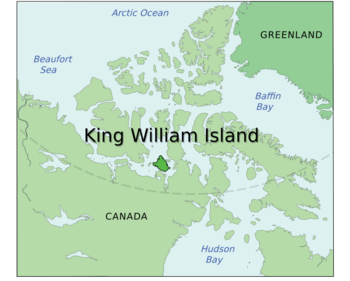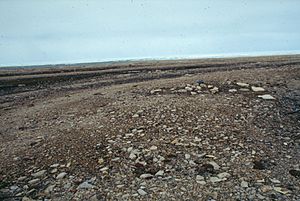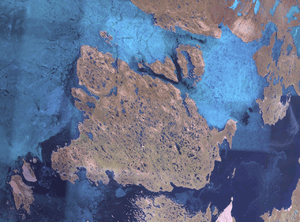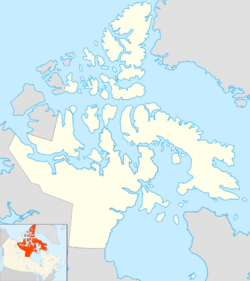King William Island facts for kids
|
Native name:
Qikiqtaq
|
|
|---|---|
 |
|
| Geography | |
| Location | Northern Canada |
| Coordinates | 69°10′N 97°25′W / 69.167°N 97.417°W |
| Archipelago | Arctic Archipelago |
| Area | 13,174 km2 (5,087 sq mi) -13,111 km2 (5,062 sq mi) |
| Area rank | 61st |
| Coastline | 1,466 km (910.9 mi) |
| Highest elevation | 141 m (463 ft) |
| Highest point | Mount Matheson |
| Administration | |
|
Canada
|
|
| Territory | Nunavut |
| Largest settlement | Gjoa Haven (pop. 1,349) |
| Demographics | |
| Population | 1,349 (2021) |
| Pop. density | 0.1 /km2 (0.3 /sq mi) |
| Ethnic groups | Inuit |
King William Island is a large island in Nunavut, Canada. It is part of the Arctic Archipelago, a group of islands in the far north. The island is also known by its Inuktitut name, Qikiqtaq.
King William Island is about 13,111 km2 (5,062 sq mi) in size. This makes it the 61st largest island in the world. It is also Canada's 15th largest island. In 2021, 1,349 people lived on the island. Everyone lives in the only community, Gjoa Haven. Many explorers visited this island while searching for the Northwest Passage.
Contents
Discover the Geography of King William Island
King William Island is surrounded by water and other landmasses. To the northeast, the James Ross Strait separates it from the Boothia Peninsula. The Rae Strait is to the east.
To the west, you'll find the Victoria Strait. Beyond that is Victoria Island. South of King William Island, within the Simpson Strait, is Todd Island. Further south is the Adelaide Peninsula. The Queen Maud Gulf lies to the southwest.
The island has many interesting coastal spots. These include Cape Felix, Victory Point, and Gore Point. You can also find Point Le Vesconte, Erebus Bay, and Cape Crozier. On the south side are Terror Bay, Irving Islands, and Washington Bay. Other spots include Cape Herschel, Gladman Point, and the entrance to Simpson Strait. The Todd Islets are also nearby. On the east side, you'll find Gjoa Haven, Matheson Peninsula, and Latrobe Bay. Cape Norton, Matty Island, Tennent Islands, and Clarence Islands are also along the coast.
Wildlife on King William Island
King William Island is famous for its many barren-ground caribou. These caribou spend their summers on the island. In the autumn, they migrate south. They walk across the frozen sea ice to reach their winter grounds.
Exploring Arctic History: King William Island's Role
King William Island has a rich history of Arctic exploration. Many famous explorers visited or stayed here.
Early Explorers and the Island's Name
The Inuit people lived on King William Island for a long time. They had a special culture that helped them survive in the harsh Arctic environment.
In 1830, a British explorer named James Clark Ross arrived. He named the land "King William Land" after William IV, who was the king of the United Kingdom. Ross first thought it was a peninsula, not an island. Some people say his uncle, John Ross, was the one who named it.
Later, in 1834, another explorer named George Back saw the island's south shore. He was the first to realize it was an island.
Sir John Franklin's Lost Expedition

About ten years after Ross, Sir John Franklin led another British expedition. He was also looking for the Northwest Passage. In 1846, his two ships got stuck in the sea ice. They were northwest of King William Island.
After leaving their ships, most of Franklin's crew died. They suffered from cold and hunger. They were trying to walk south along the western coast. Two of Franklin's men were buried at Hall Point on the island's south coast. For many years, the ships were thought to be lost forever. Many search parties tried but failed to find them.
On June 29, 1981, researchers finally found something. A team led by Canadian archaeologist Owen Beattie found 31 human bone fragments. These were found at Booth Point, on the southern tip of the island.
Years later, on September 9, 2014, Canada's Prime Minister Stephen Harper made a big announcement. The Victoria Strait Expedition had found one of Franklin's ships. It was in shallow water south of King William Island. The ship was in very good condition. Special sonar equipment could even see the deck planks. By October, the wreck was identified as HMS Erebus. The other ship, HMS Terror, was found in 2016. It was in Terror Bay, off the island's southwest coast.
Roald Amundsen's Winter Stays

In 1903, Norwegian explorer Roald Amundsen sailed through the James Ross Strait. He was also looking for the Northwest Passage. He stopped at a natural harbor on the island's south coast. The sea ice prevented him from going further. So, he spent two winters there: 1903–1904 and 1904–1905.
During his time on the island, Amundsen learned a lot. He learned Arctic survival skills from the local Netsilik people. He used his ship, Gjøa, as a base. In the summer of 1904, he explored by dogsled. He traveled to the Boothia Peninsula and the North Magnetic Pole. After 22 months, Amundsen left the island in August 1905. The harbor where he stayed is now the site of Gjoa Haven, the island's only settlement. Amundsen used the skills he learned from the Inuit for his later trip to the South Pole.
George Porter: An Arctic Life
George Porter was born in 1895 on a whaling ship near Herschel Island. His mother was Mary Kappak, and his father was W.P.S. Porter. George went to school in Alaska. In 1913, he worked as a sailor on the ship Elvira. He traveled with the explorer Vilhjalmur Stefansson.
After a short time working with reindeer in Siberia, he joined the US military. This was near the end of the First World War. In 1919, George left the Army in Iowa. In 1921, he sailed to Australia. Later, George became a guide for Royal Canadian Mounted Police (RCMP) commander Henry Larsen. He guided Larsen on many trips.
George Porter eventually made Gjoa Haven on King William Island his home. He worked there for 25 years. He was the manager of the Hudson's Bay Company trading post.
Climate of King William Island
King William Island has a tundra climate. This means it has long, cold winters. The summers are cool, and only some of the ice melts. There is also very little rain or snow, making it a "cold desert."
| Climate data for Gjoa Haven (Gjoa Haven Airport) Climate ID: 2302335; coordinates 68°38′08″N 95°51′01″W / 68.63556°N 95.85028°W; elevation: 46.9 m (154 ft); 1991–2020 normals, extremes 1984–present |
|||||||||||||
|---|---|---|---|---|---|---|---|---|---|---|---|---|---|
| Month | Jan | Feb | Mar | Apr | May | Jun | Jul | Aug | Sep | Oct | Nov | Dec | Year |
| Record high humidex | −4.6 | −11.3 | −6.6 | 0.2 | 5.5 | 19.4 | 26.7 | 26.8 | 16.0 | 4.2 | −0.6 | −1.9 | 26.8 |
| Record high °C (°F) | −4.4 (24.1) |
−11.0 (12.2) |
−5.0 (23.0) |
1.0 (33.8) |
6.5 (43.7) |
20.8 (69.4) |
24.4 (75.9) |
24.0 (75.2) |
15.4 (59.7) |
4.5 (40.1) |
−0.5 (31.1) |
−2.0 (28.4) |
24.4 (75.9) |
| Mean daily maximum °C (°F) | −29.6 (−21.3) |
−30.3 (−22.5) |
−25.4 (−13.7) |
−15.9 (3.4) |
−5.7 (21.7) |
4.6 (40.3) |
12.4 (54.3) |
9.7 (49.5) |
2.5 (36.5) |
−5.7 (21.7) |
−17.2 (1.0) |
−24.6 (−12.3) |
−10.4 (13.3) |
| Daily mean °C (°F) | −32.9 (−27.2) |
−33.6 (−28.5) |
−29.3 (−20.7) |
−20.2 (−4.4) |
−9.1 (15.6) |
1.7 (35.1) |
8.4 (47.1) |
6.5 (43.7) |
0.4 (32.7) |
−8.4 (16.9) |
−20.7 (−5.3) |
−28.0 (−18.4) |
−13.8 (7.2) |
| Mean daily minimum °C (°F) | −36.0 (−32.8) |
−36.4 (−33.5) |
−32.9 (−27.2) |
−24.4 (−11.9) |
−12.4 (9.7) |
−1.1 (30.0) |
4.2 (39.6) |
3.3 (37.9) |
−1.7 (28.9) |
−11.1 (12.0) |
−24.2 (−11.6) |
−31.4 (−24.5) |
−17.0 (1.4) |
| Record low °C (°F) | −48.3 (−54.9) |
−50.2 (−58.4) |
−46.3 (−51.3) |
−41.1 (−42.0) |
−28.2 (−18.8) |
−17.0 (1.4) |
−1.2 (29.8) |
−5.0 (23.0) |
−14.3 (6.3) |
−32.0 (−25.6) |
−39.4 (−38.9) |
−44.0 (−47.2) |
−50.2 (−58.4) |
| Record low wind chill | −64.2 | −65.3 | −66.5 | −54.0 | −39.4 | −21.9 | −6.8 | −12.9 | −21.2 | −48.1 | −55.0 | −62.5 | −66.5 |
| Average precipitation mm (inches) | 7.9 (0.31) |
6.0 (0.24) |
12.7 (0.50) |
15.4 (0.61) |
12.0 (0.47) |
15.3 (0.60) |
20.9 (0.82) |
31.8 (1.25) |
25.8 (1.02) |
25.6 (1.01) |
10.7 (0.42) |
8.7 (0.34) |
192.7 (7.59) |
| Average rainfall mm (inches) | 0.0 (0.0) |
0.0 (0.0) |
0.0 (0.0) |
0.0 (0.0) |
1.3 (0.05) |
11.7 (0.46) |
19.4 (0.76) |
30.4 (1.20) |
14.0 (0.55) |
1.1 (0.04) |
0.0 (0.0) |
0.0 (0.0) |
77.9 (3.06) |
| Average snowfall cm (inches) | 11.2 (4.4) |
9.8 (3.9) |
19.8 (7.8) |
17.1 (6.7) |
15.4 (6.1) |
4.6 (1.8) |
0.5 (0.2) |
0.5 (0.2) |
9.8 (3.9) |
32.7 (12.9) |
14.2 (5.6) |
12.2 (4.8) |
147.8 (58.3) |
| Average precipitation days (≥ 0.2 mm) | 8.8 | 6.0 | 9.7 | 8.9 | 8.7 | 8.6 | 9.7 | 12.7 | 12.9 | 16.0 | 11.9 | 9.7 | 123.6 |
| Average rainy days (≥ 0.2 mm) | 0.0 | 0.0 | 0.0 | 0.0 | 0.63 | 5.6 | 8.8 | 11.4 | 7.7 | 0.53 | 0.0 | 0.0 | 34.7 |
| Average snowy days (≥ 0.2 cm) | 8.9 | 6.3 | 9.9 | 9.4 | 8.7 | 1.9 | 0.22 | 0.53 | 6.3 | 15.3 | 11.2 | 8.7 | 87.4 |
| Average relative humidity (%) (at 3pm) | 69.0 | 69.1 | 73.9 | 81.5 | 86.2 | 81.2 | 70.3 | 75.5 | 83.4 | 88.4 | 80.2 | 73.7 | 77.7 |
| Source: Environment and Climate Change Canada | |||||||||||||
See also
 In Spanish: Isla del Rey Guillermo para niños
In Spanish: Isla del Rey Guillermo para niños




